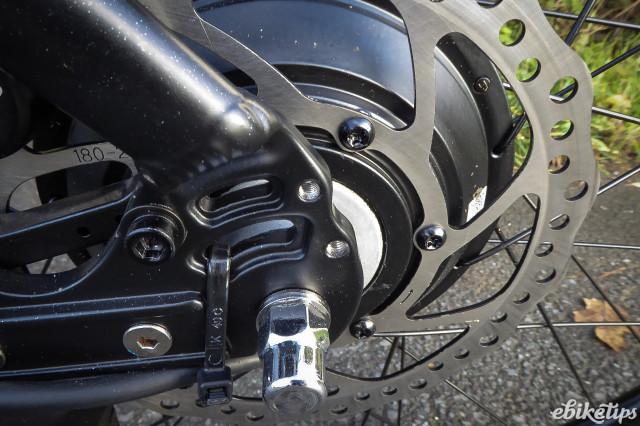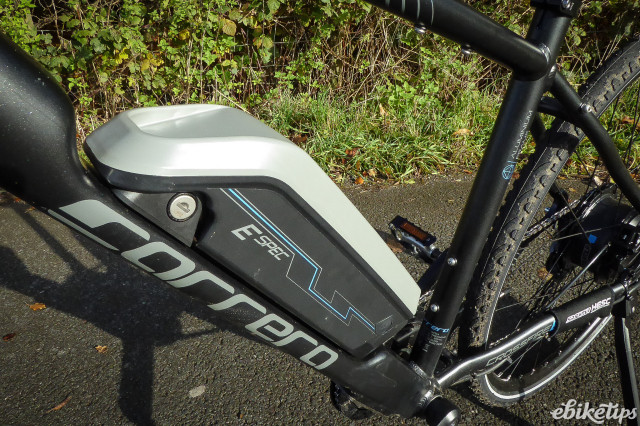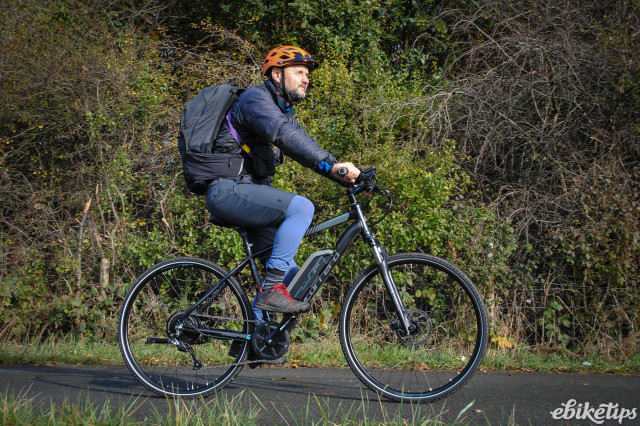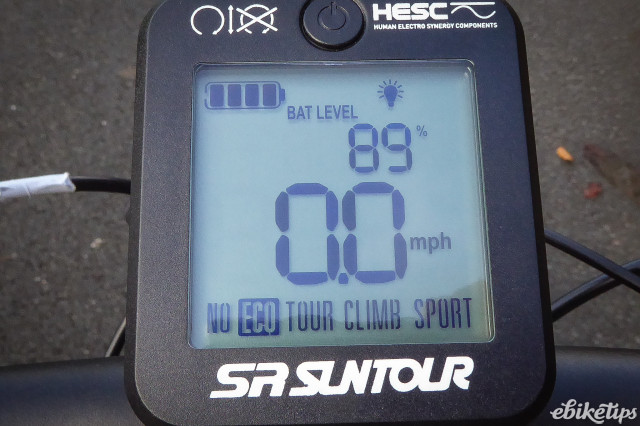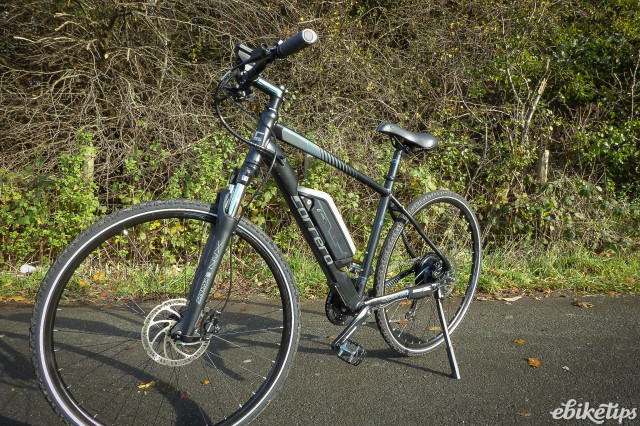Carrera Crossfire E 2020
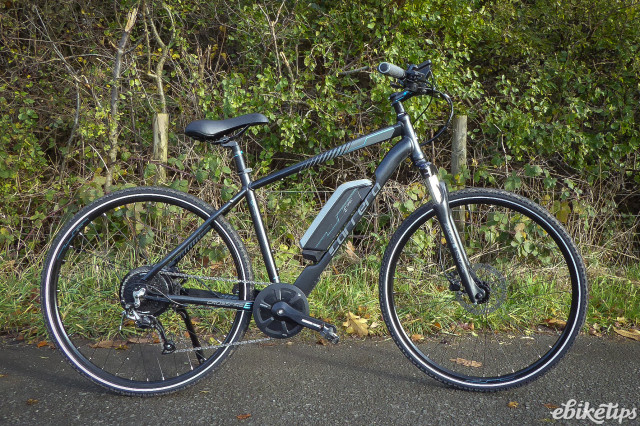
Overview
- Sportier, more powerful spec of the Suntour HESC rear hub motor
- Fast, sporty ride feel and a nice resistance-free ride without power too
- Torque sensing for a natural ride feel
- LED lighting, mudguards and pannier rack would make it standout value for money
- Motor relatively heavy
Carrera is Halfords own-brand budget range of regular and electrically-assisted e-bikes. Their latest 2020 model year, hybrid-style electric offering is the Crossfire E which uses a rear hub motor from far-eastern component manufacturer SR Suntour (of budget suspension fork fame).
Buy the Carrera Crossfire E here
eBikeTips has already reviewed three other Carrera e-bikes with the HESC motor system, the Carrera Vengeance E e-mtb, the Carrera Subway E hybrid and the Carrera Crossroad E.
The motor history is detailed in the Vengeance report, where it’s reported that the HESC system first appeared about 2011. It was never really widely adopted, no doubt because it’s launch coincided with Bosch’s mid-drive launch which revolutionised the e-bike scene and also because the huge motor manufacturer Bafang had already been developing very cost effective (but not as sophisticated) hub motors for quite a while. Despite that, HESC offers a lot of technology for the money and generally gives an impressive riding experience.
I felt the Vengeance E was a little underpowered, especially for an e-mtb, but the good news for those eyeing the Crossfire E is that it uses an upgraded, higher torque version of the motor.
Spec
This looks like a fast but stable and comfortable hybrid design of e-bike, handy for commuters and capable of light off-road riding thanks to the 28” Kenda K-935 (42-622) tyres that feature a smoothish central ridge for the tarmac and a more aggressive tread pattern on the side.
The crossbar frame on my test bike was well-made and smoothly finished and it’s nice to see there is a step-through option too which makes a great option for riders who need to hop and off a lot or simply don’t like or have difficulty swinging a leg over the saddle.
The controller is well hidden away in the bottom part of the downtube but looks easily accessible via a removable metal cover should it ever need to be replaced. The 417Wh battery is also on the downtube and key removable in the usual way.
Like many e-bikes at this price it looks a little clunky and obvious, with little attempt make it look a little more integrated into the frame. The upside of that is that it is dead easy to take off and put back on, so it’s very easy to recharge off the bike (though it’s still possible to charge it on the bike if you want to).
The steel sprung front suspension Suntour NVX forks are rated at 75mm of travel and changing is courtesy of 9 Shimano Altus gears – both about what you expect to see on a budget e-bike and are adequate rather than standout in performance terms. Very welcome are the Tektro hydraulic disc brakes.
Due to increased economies of scale and greater manufacturers’ realisation they are perfect fit for the extra weight of e-bikes, hydraulic disc brakes are far commoner than they once were on e-bikes. The bike comes with a sturdy kickstand but it’s a little disappointing to see no mudguards, rack or lights on a model specifically aimed at commuters and whose price is creeping up above the £1000. There are mounting points on the frame for both rear rack and mudguards.
Motor and Battery Upgrade
The other Suntour HESC-powered bikes detailed above all retail at £999 so what do you get for the extra money the Crossfire-E will cost you? There is a bigger capacity battery that should take you further on a single charge (though at 417Wh it’s a bit below the modern Bosch / Shimano standard of 500Wh) and a removable (nice touch) LCD display with all sorts of info on it (cheaper models come with a less informative LED display that only shows power levels and battery capacity. Best of all though is the more powerful motor; the Carrera Vengeance e-mtb I tried previously was a great value bike but noticeably lacked a some real climbing punch up the steeper hills. The higher torque model on the Crossfire promised much better performance.
The motor remains rather large by modern hub motor standards so not surprisingly the weight of the Crossfire is on a par with the other HESC models at 22.85kg and whilst not shockingly heavy for an e- bike, it’s nothing write home about either.
The Ride
The first thing to say is the more powerful motor on the Crossfire was immediately noticeable when compared to my previous experience of the HESC system on the Vengeance. It was not only quick out of the blocks but it maintained its speed up hills. On my regular mile long tarmac hill climb it also returned a time that was in the middle of the leading peloton of previous test bikes that have included some fine quality mid-drives.
On my test up the ‘steepest tarmac bike path I have ever found’ test the motor climbed with ease where smaller hub motors have struggled - though it was no doubt a little slower than top of the line crank motors. However the 9 speed derailleur gearing with a 335% range and an easy to pedal 31” bottom gear will be welcome news to those who want tackle steep hills whilst keeping up plenty of speed downhill (I topped out at around 28mph down one long very steep gradient).
All Ebiketips’ previous reviews of the HESC systems loved the smooth power delivery, delivered by their own unique torque sensing system housed in the large plastic disc affair attached to the chainwheel, and this one is no exception. The system senses the pressure you put on the pedals rather than the movement of the cranks or chainwheel as inferior speed sensing systems do. The result is more immediate power delivery that is much more in tune with you pedalling action.
The power feels smoother and more in proportion to the effort you are putting into pedalling (especially important for hill climbing and close control of the bike in busy traffic) and it should also mean more efficient use of the battery power, with no inefficient run-ons or power surges. There is some distinctly audible noise in the higher power levels, but it is not too loud and sounds like the background whirring of a high pitched sewing machine. With the increased power of the upgraded motor I would say this iteration of the HESC is the best hub motor system I have tried at this price. The bike’s 28” tyres and comfortable seating saddle and position mean safe feeling and stable handling too.
The centrally-mounted display is nice and large and legible with great basic info including speed, odometer, trip distance and battery capacity in % points – so much more useful than the ‘blocks in a battery’ graphics which are one of my pet hates on e-bikes. It removes quickly and easily as a useful way of making the bike a bit less of an attractive target to thieves and the text on it is nice and large, great for riders whose eyesight is not as sharp as it once was. The power levels are easy to adjust, even with gloves on, as the raised buttons on the control module by your left thumb are very easily felt. There is even a button there that lets you dim the backlight on the display for more comfortable night riding.
Removing the display reveals an old style mini-USB charging port in the display mounting block that indicates it will charge 5V devices that will detect a 0.5A current (I couldn’t test this as I didn’t have a compatible lead to hand). All in all one of the most practical displays I have seen though a clock function would have made it a ten out of ten.... My range estimate was around 35-45 miles in fairly hilly terrain where I didn’t find the top power level necessary to get up to max speed very often. The usual caveats about how long (or short) is a piece of string apply though when it comes to any range estimate.
Summary
There’s loads to like about this bike, especially the torque sensing and pretty powerful hub motor. My only reservation is that as the price starts to creep over £1000 you start to head towards being able to afford a crank drive system with a very high quality motor; a quick Google just pops up a £1400 Bosch-powered machine for example. No doubt if you shopped around you could trim quite a bit off this price too. These machines generally have such a great reputation for reliability and efficiency it would be hard for any HESC-powered machine to compete once they are in the same price bracket.
But at the more or less a £1000 price bracket the Crossfire remains very good value and an e-bike that should be on any budget commuter / leisure bike shortlist.
1 comments
Buyer beware with the CrossFire E: My partner originally had the earlier version which suffered from regular intermittent cutting out. Halfords replace that with the latest version, which looks to have improved electrical cable routing and has a different (and vastly worse) battery charging socket. That one lasted less than a week before it started cutting out too.
When we took the second one back the chap in the shop admitted they'd had problems with bikes with the Suntour set up. Halfords were excellent about the whole thing and gave us a full refund on the second one which we used to buy a bike with a midmounted Bosch motor. As the review says, now those are down to < £1500 I'd definitely recommend the Bosch. "Buy cheap, buy twice" proved accurate in this case.
We are no buy no means an isolated incident of this as googling Crossfire E will quickly confirm. I think the reviewers should really be covering this, it's been a known issue for years.
